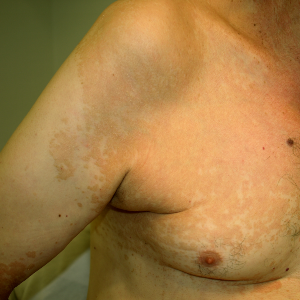Pityriasis versicolor: host susceptibility in relation to IL-10 and IFN-γ cytokine gene polymorphism

Accepted: 7 June 2023
HTML: 18
All claims expressed in this article are solely those of the authors and do not necessarily represent those of their affiliated organizations, or those of the publisher, the editors and the reviewers. Any product that may be evaluated in this article or claim that may be made by its manufacturer is not guaranteed or endorsed by the publisher.
Pityriasis versicolor is a skin condition caused by the commensal yeast Malassezia. Little is known about the pathogenesis of why a commensal only causes symptoms in a subset of infected individuals. Understanding the susceptibility of the host to these commensal-associated diseases may be facilitated by knowledge of genetic polymorphism. The purpose was to investigate the relationship between Single Nucleotide Polymorphism in the IL10 and IFN genes of the host and susceptibility to Malassezia infection. There were 38 cases of Pityriasis Versicolor (PV) and 38 healthy controls in the sample. Blood samples were extracted for genomic DNA from all study participants. Amplification refractory mutations system- polymerase chain reaction (ARMS-PCR) with sequence-specific primers was used to genotype cytokines. In all patients and healthy controls, three SNPs (IL10-1082A/G; IL10-819/592C/T; IFN– +874A/T) in two cytokine loci were analyzed. In the PV group, we observed significant differences in allele or genotype distribution for the IL10-819/592C/T and IFN– +874A/T gene polymorphisms. In the present investigation, cytokine gene polymorphism revealed that the host was susceptible to Malassezia infection.
Ashbee HR, Evans EG. Immunology of Diseases Associated with Malassezia Species. Clin Microbiol Rev 2002;15:21–57. DOI: https://doi.org/10.1128/CMR.15.1.21-57.2002
Thomas DS, Ingham E, Bojar RA, Holland KT. In vitro modulation of human keratinocyte pro- and anti-inflammatory cytokine production by the capsule of Malassezia species. FEMS Immunol Med Microbiol 2008;54:203–14. DOI: https://doi.org/10.1111/j.1574-695X.2008.00468.x
Cafarchia C, Otranto D. Association between phospholipase production by Malassezia pachydermatis and skin lesions. J Clin Microbiol 2004;42:4868-9. DOI: https://doi.org/10.1128/JCM.42.10.4868-4869.2004
Choe YB, Jang SJ, Yim SM, Ahn KJ.The quantitative study on the distribution of Malasseziayeasts on the normal skin of the young adults. Korean J Med Mycol 2004;9:174-81.
Forke R, Jäger A, Knölker HJ. First total synthesis of clausine L and pityriazole, a metabolite of the human pathogenic yeast Malassezia furfur. Org Biomol Chem 2008;21:2481-3. DOI: https://doi.org/10.1039/b805451g
Carvalho A, Cunha C, Pasqualotto AC, et al. Genetic variability of innate immunity impacts human susceptibility to fungal diseases. Int J Infect Dis, 2010; 14:460-8. DOI: https://doi.org/10.1016/j.ijid.2009.06.028
Afzal MS, Tahir S, Salman A, et al. Analysis of interleukin-10 gene polymorphisms and hepatitis C susceptibility in Pakistan. J Infect Dev Ctries 2011;5:473-9. DOI: https://doi.org/10.3855/jidc.1338
Ansari A, Hasan Z, Dawood G, Hussain R. Differential combination of cytokine and interferon-γ +874 T/A polymorphisms determines disease severity in pulmonary tuberculosis. PLoS One 2011;6:27848. DOI: https://doi.org/10.1371/journal.pone.0027848
Han A, Calcara DA, Stoecker WV, Daly J, Siegel DM, Shell A. Evoked scale sign of tinea versicolor. Arch Dermatol 2009;145:1078. DOI: https://doi.org/10.1001/archdermatol.2009.203
Shi VS, Lio PA. Diagnosis of Pityriasis versicolor in paediatrics: the evoked scale sign. Arch Dis Child 2011;96:392–3. DOI: https://doi.org/10.1136/adc.2010.200238
Little, S. Amplification-Refractory Mutation System (ARMS) Analysis of Point Mutations. Curr Protoc Hum Genet 2001;9:9.8.
Manne M, Gunde S, Kondreddy RK, et al. Association of IFN-g+874(T/A) polymorphism with female patients of age-related cataracts. J Ophthalmol 2012;5:32–6. DOI: https://doi.org/10.4103/0974-620X.94764
Armstrong RA. When to use the Bonferroni correction. Ophthalmic Physiol Opt 2014;34:502-8. DOI: https://doi.org/10.1111/opo.12131
Ahn, KJ. Taxonomy of the genus Malassezia. Korean J Med Mycol 1998;3:81-8.
el-Hefnawi H, el-Gothamy Z, Refai M. Studies on Pityriasis versicolor in Egypt. I Incidence Mykosen 1971;14:225–31. DOI: https://doi.org/10.1111/j.1439-0507.1971.tb03041.x
Mayser P, Gaitanis G. Physiology and biochemistry. In: Malassezia and the skin. Science and clinical practice. 2010th edition. Boekhout T, Guého E, Mayser P, Velegraki A, eds. Springer, Berlin, Germany, 2010; p. 121–38. DOI: https://doi.org/10.1007/978-3-642-03616-3_4
Rezaee MA, Motaharinia Y, Hosseini W, et al. Natural oils enhance IL-10 & IFN gamma production by human PBMCs cultured with Malassezia furfur. Iran J Immunol 2012;9:100-19.
Buentke E, Zargari A, Heffler LC, et al. Update on the genus Malassezia furfur & its allergenic components by human immature CD1a+ dendritic cells. Clin Exp Allergy 2000;30:1759-70. DOI: https://doi.org/10.1046/j.1365-2222.2000.00937.x
Valli JL, Williamson A, Sharif S, et al. In vitro cytokine responses of peripheral blood mononuclear cells from healthy dogs to distemper virus, Malassezia & Toxocara. Vet Immunol Immunopathol 2010;134:218-29. DOI: https://doi.org/10.1016/j.vetimm.2009.09.023
Akaza N, Akamatsu H, Takeoka S, et al. Increased hydrophobicity in Malassezia species correlates with increase proinflammatory cytokine expression in human kertatinocytes. Med Mycol 2012;50:802-10. DOI: https://doi.org/10.3109/13693786.2012.678019
Buentke E, Heffler LC, Wallin RP, et al. The allergenic yeast Malassezia furfur induces maturation of human dendritic cells. Clin Exp Allergy 2001;31:1583-93. DOI: https://doi.org/10.1046/j.1365-2222.2001.01199.x
Neuber K, Kroger S, Gruseck E, et al. Effects of Pityrosporum ovale on proliferation, immunoglobulin (IgA, G, M) synthesis and cytokine (IL-2, IL-10, IFN gamma) production of peripheral blood mononuclear cells from patients with seborrhoeic dermatitis. Arch Dermatol Res 1996;288:532–6. DOI: https://doi.org/10.1007/BF02505250
Balestri R, Rech G, Piraccini B, et al. Pityriasis versicolor during anti TNF alpha monoclonal antibody therapy: therapeutic consideration. Mycoses 2012;55:444-6. DOI: https://doi.org/10.1111/j.1439-0507.2012.02170.x
Copyright (c) 2023 the Author(s)

This work is licensed under a Creative Commons Attribution-NonCommercial 4.0 International License.


 https://doi.org/10.4081/hls.2023.11302
https://doi.org/10.4081/hls.2023.11302



